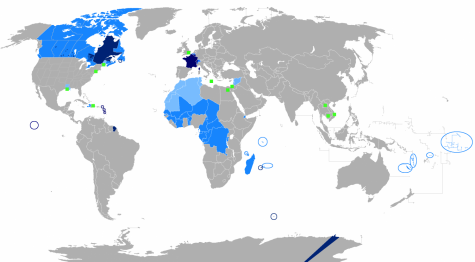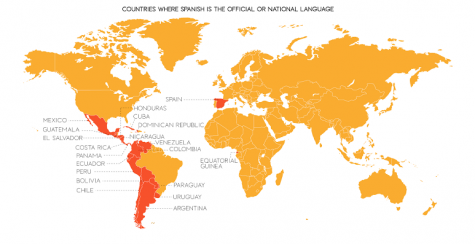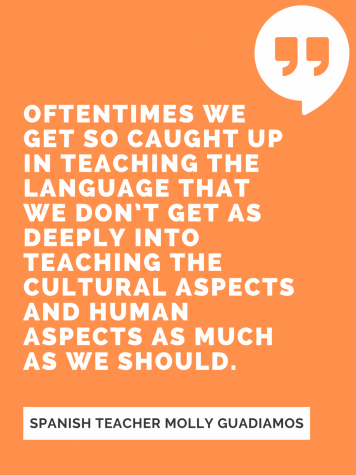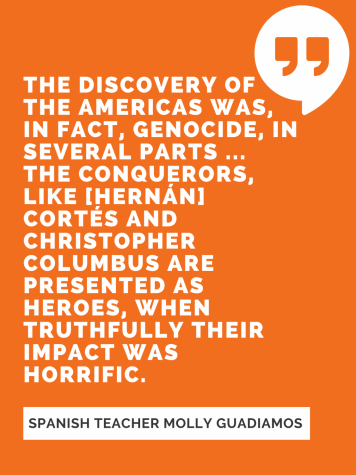MVHS Spanish and French teachers implement a stereotype unit
Delving into aspects of anti-racist work through Spanish and French 4 Honors curriculum
October 5, 2020
“Why are we learning about monuments in Paris?”
Last year, when a student asked French teacher Sarah Finck this question midway through their unit on Parisian culture, she instinctively thought, “Challenging, but fair question.” She then went on to explain that if her students were to hypothetically visit French-speaking places like Paris in the future, they may want to know what sites to visit. On a deeper level, though, Finck believes that the purpose of learning French is more than just visiting places or conjugating verbs — she says contextualizing the language through history and culture makes the class more enjoyable, as well as meaningful.
This decision to contextualize languages manifested in a more significant way this year, when Finck and Spanish teacher Molly Guadiamos decided to collaborate through their secondary Professional Learning Community. Although PLCs are usually course alike, Finck and Guadiamos work together since they are the sole Spanish and French teachers that teach Level 4 Honors classes. Linguistically, many of their communication goals are similar, as well as content, grammar and speaking skills, which makes the collaboration feasible.
While researching ways to modify her curriculum for this year, Finck came across a site called Madame’s Musings, where another language teacher had compiled resources for universal use. The first unit was a stereotype unit, which Finck decided to implement during the first couple weeks of the 2020-21 school year.
“I was trying to shift things around for myself and for the students given that it’s [on] Zoom,” Finck said. “And the stereotype unit, first of all, it did align pretty well with some, not exactly anti-racist work, but the notion of paying attention to what we assume about other people and what may or may not be true, so I thought it fit well with that. I [had most of] these students in French 2, so I know them and [was] comfortable diving into whatever.”

Similarly, Guadiamos had been researching and tracing developments of the Black Lives Matter movement over the summer. After independently doing some reading and reflecting, she considered the implications race-related issues could potentially have for her students.
“I was reflecting on … what I might do differently, to help address some underlying issues, which I believe often stem [from a] lack of education about the issue,” Guadiamos said. “I was specifically thinking about how this issue applies to the Latinx population as well. That’s my area of teaching, and definitely Latinos are right in there … dealing with the same kind of issues. I wanted to incorporate specifically some work in that area into my curriculum.”
Coincidentally, the stereotype unit that Finck had found aligned perfectly with what Guadiamos was looking for. Through their PLC collaboration, Guadiamos was able to discover and modify it, eventually teaching the unit a few weeks after Finck.
Guadiamos adds that due to the discrimination that the Latinx population faces in the U.S., she felt that it was especially important for her to address how to break down and combat these stereotypes.
Junior Leelavathi Srinivas, a Spanish 4 Honors student in Guadiamos’ class, compares the stereotype unit to some of the anti-racist work that has taken place in Advisory recently, such as the Pyramid of Hate lesson that was taught on Wednesday, Sept. 29. Although she appreciates the anti-racist content taught in Advisory, she notices that a lot of it was prior knowledge for her, unlike her experience with the Spanish unit.
“In Spanish, I feel like it was more nuanced because I guess the focus [was that] stereotypes are inevitable in that we all have them, we all know them and they can become normalized, in a sense,” Srinivas said. “I feel like [in our community], we don’t see that many Latinx people, so we don’t really think about it that much, but then that also doesn’t really give us an opportunity to challenge stereotypes that we have that are pervasive … I feel like this was a good opportunity to break through those stereotypes and sort of challenge [them].”
Finck explains that she was able to integrate this unit at the start of the year because the textbook is structured so that each chapter correlates with a place in the Francophone world — for instance, chapter one is Paris, and chapter two is Quebec. Using the theme of location as a starting point, she instructed students to research monuments, alongside the additional context which she found for this specific unit.

“Some of the stereotypes are silly, [and for] some of them, [the students] probably didn’t know about [them] beforehand, like the stereotype that French people don’t shave as much as Americans or that they smell,” Finck said. “I had the students pick a stereotype and research why we may think it’s true and what’s behind it, and if it’s actually true. Do the French smoke more than everyone else? There’s a stereotype of a French person with a cigarette. The data seems to say that among Europeans, they’re actually not the ones who smoke the most. So in the end, report back to what degree the stereotypes are true.”
Finck adds that unlike the Latinx stereotypes, the French ones tended to be more light-hearted, such as the stereotype that all French people eat weird things like snails, or that they all wear berets and striped shirts. She attributes this to the systemic status that the French possess, due to French culture currently being a dominant one, and citing the historical aspects of an expansive French empire and the country’s colonization successes.
“People admire [France] — their main industry is tourism,” Finck said. “People have romanticized views of the language, or the way people dress. Some of the stereotypes on our list were like, they all dress nicely. So, of course, it’s not true that everyone dresses nicely all the time. But the fashion industry is a major industry in France, and [how they look] is important for them. So I think I would attribute it to status like that, and that if you have a population that isn’t seen as possessing power in the world, then they’re more at risk for a [harmful] stereotype.”
Finck believes that her unit did not go as in-depth as the Spanish one — they did not compare French stereotypes to those of other communities — but her students were nevertheless able to demonstrate a nuanced understanding of the issues surrounding stereotypes.
“I would say that I can hear the maturity in a lot of my students’ answers where they say, ‘Obviously, no stereotype is completely true,’” Finck said. “‘Probably not completely false. And it’s unfair to say all French people do this thing.’ And so I think that students have a really good sense of what reality is.”
Finck says that Guadiamos’s unit had additional depth, due to the proximity of living among Latinx people — in contrast with the limited numbers of French-Americans in our community — as well as controversial, harmful stereotypes. She says that stereotypes like all Latinx people work in restaurants can be dangerous, but that Guadiamos was able to conduct powerful work — for instance, having students discover accomplished people of Latinx heritage and highlighting the strengths of their community.
“The point of a professional learning community is we learn from each other,” Finck said. “So I told her what I had done, and she added a level, which I think I would try to do next time, which was she had the students categorize where the stereotype comes from. Does it come from ignorance? Or does it come from fear? Or does it come from hate? Or does it come from an emotional reaction? And that allowed the students to understand why we may have those ideas, and then I think she also asked them, what are the consequences of it? It was neat to see how she ran with the idea.”
Srinivas explains that doing this exercise — looking up stereotypes and understanding the reasoning behind its fallacies — was useful and eye-opening for her. She remembers a false generalization she discovered about Latinx people always being dramatic, as well as a stereotype stating that they are violent, which was really shocking for her to hear.
Like Finck, Guadiamos chose to transition into this unit using the textbook, in which the first chapter included articles about the Latinx population in the U.S. and presented some key influential Latinx-Americans. Guadiamos’ goal was to subvert harmful stereotypes by making it clear to her students that the Latinx community is accomplished and intelligent, so this served as a natural tie to the stereotype unit.

Additionally, since much of the curriculum also focuses on the diversity and differences in the Spanish-speaking world, Guadiamos brought awareness to this notion by having students read articles about stereotypes that people from certain parts of the Spanish-speaking world have about other parts. She notes that people often have limited knowledge and will, for instance, incorrectly assume that Spanish and Mexican culture are synonymous.
“The most important thing is just to call attention to the stereotypes,” Guadiamos said. “I think it really links in a lot with what we’re working on in Advisory. We’re talking about what stereotypes may seem really harmless on the surface, but they lead to discriminatory practices and worse. Getting them to reflect, look at, think and take those apart at the lowest level I think really helps and is something that we really need to do.”
As the unit progressed, Guadiamos wanted to work to combat the association between Latinx people and certain areas of work. Therefore, she gave her students the choice to pick and investigate a Latinx professional that has made significant contributions in industries such as music, business and finance, and provided lists of such people, including the surgeon general of the U.S., Supreme Court justices, Olympians, Nobel laureates, community leaders, activists, politicians and other areas involving prominent Latinx people.
“It was interesting to see which ones they picked,” Guadiamos said. “People were often like, ‘Oh I’m interested in medicine, let’s go find somebody in science,’ or ‘I’m interested in technology, so let me go find this Latino who works for NASA.’ So those kinds of things really helped to break this idea that Latinos work in one particular industry, in the service sector, which is absolutely ridiculous.”
Guadiamos was satisfied with the receptiveness of her students and appreciates that their choices weren’t arbitrary and instead, reflected interest. She also cites how some of her students even found interesting articles that debunked stereotypes, such as one about “Hispennials” and how they are more likely than any other group to buy a home, attesting to their economic power.
On a similar note, Srinivas says she appreciated this activity’s attempt to correct prejudices. She chose to research Alexandria Ocasio Cortez, the U.S. Representative for New York’s 14th Congressional District. Learning about her background, as well as her involvement with her own campaign and volunteering for the Bernie Sanders campaign, was inspiring for Srinivas.

“If you’re learning Spanish, it’s really just counterintuitive if you’re going to hold prejudices against a community that speaks Spanish,” Srinivas said. “If you’re going to learn, I feel like you need to have an open mind. Because there’s a lot of diversity among Spanish-speaking communities, and it’s important not to stereotype … any community of Spanish-speaking people. Any stereotype can be harmful, and any generalization, for any community, just isn’t right.”
Guadiamos agrees, adding that breaking stereotypes can be effective through education because often, generalizations stem from seeing people as outsiders. Learning more about groups in general, and the people within those groups, can help divert these stereotypes.
“[This is] important context in the language class because these are the people who speak the language,” Guadiamos said. “You need to learn not just the language, but also the people, the culture. Learning the many aspects of culture within a Spanish-speaking world, that’s a key part of what we’re supposed to teach in the language classroom, but oftentimes we get so caught up in teaching the language that we don’t get as deeply into teaching the cultural aspects and human aspects as much as we should.”
Additionally, Guadiamos mentions that she has encountered stereotypes and oversimplifications about individuals and events while teaching the course through the lens of textbooks, which often present Eurocentric viewpoints. She cites a specific textbook that was previously used in the Spanish 3 course, where indigenous people received little to no mention, and the colonization of the Americas was portrayed in an oversimplified, positive manner.
“I think it really doesn’t adequately present the horrific impact it had on the indigenous population,” Guadiamos said. “The discovery of the Americas was, in fact, genocide, in several parts … sometimes it would give a little mention, and definitely when we were doing that, I would expand on that, like did you know that pretty much the entire indigenous population in the Caribbean was wiped out? I mean, you don’t see any indigenous population there. Textbooks do not do that area any justice at all. And definitely the conquerors, like [Hernán] Cortés and Christopher Columbus are presented as heroes, when truthfully their impact was horrific.”

Extending these issues to the MVHS community, Srinivas mentions that although she liked that the unit went in-depth about generalizations and how they never display a complete picture, she wishes there had been some more discourse about racism and prejudice. While she says she hasn’t seen overt forms of discrimination, she has heard people laugh at racist jokes about Latinx people.
Guadiamos says that she generally has a couple of Latinx students per year — they range from being second or third-generation immigrants to having much more distant ancestry from Spanish-speaking countries — that are from Colombia, Spain, Venezuela, Peru, Mexico and a variety of other places. For the first several years of her career, she taught at Homestead HS, where she interacted with and taught more Latinx students. Due to her classroom being an academic environment, she did not notice overt discrimination but speculates that they have probably been subject to such outside the classroom; her husband is Latinx, and he occasionally has negative experiences that are steeped in racism.
“This isn’t, ‘And now we’re done,’” Guadiamos said. “I think this is a beginning, a beginning of building, of openness and awareness of things and also for [students] to go out there and be those interrupters if they see someone making a comment that shows stereotypes or bias — it’s important to do that.”


















